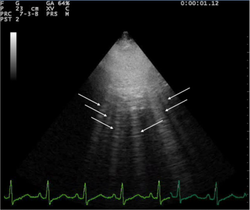Ultrasound: Lungs: Difference between revisions
Aganapathy (talk | contribs) |
No edit summary |
||
| Line 12: | Line 12: | ||
*May also identify "lung point": distinct point where you no longer see lung sliding (pathognomonic) | *May also identify "lung point": distinct point where you no longer see lung sliding (pathognomonic) | ||
*Evaluate other intercostal spaces because pneumothorax may only be seen in least dependent area of thorax | *Evaluate other intercostal spaces because pneumothorax may only be seen in least dependent area of thorax | ||
[[File:Lung Point Bowra.gif|thumbnail|Lung point<ref>http://www.thepocusatlas.com/pulmonary/</ref>]] | |||
<gallery> | <gallery> | ||
File:Z-lines and lung sliding.png | File:Z-lines and lung sliding.png | ||
Revision as of 16:37, 17 February 2018
Technique
- Use linear probe
- Can use curvilinear or phased array probe, but will need to decrease depth
- Place the probe vertically (marker toward head) over the 2nd intercostal space at the midclavicular line
- Adjust your view in order to see a rib on each side of the screen (designated by rib shadow)
- Look between the ribs for "lung sliding"
- To document sliding on a single image, use M mode ("waves on a beach")
- Can continue to evaluate each intercostal space for sliding if needed
Pneumothorax
- No lung sliding seen (not specific for pneumothorax)
- May also identify "lung point": distinct point where you no longer see lung sliding (pathognomonic)
- Evaluate other intercostal spaces because pneumothorax may only be seen in least dependent area of thorax

Lung point[1]
Pulmonary edema
- A lines and B lines
- A lines:
- Appear as horizontal lines
- Indicate dry interlobular septa.
- Predominance of A lines has 90% sensitivity, 67% specificity for pulmonary artery wedge pressure <= 13mm Hg
- A line predominance suggests that intravenous fluids may be safely given without concern for pulmonary edema
- B lines ("comets"):
- White lines from the pleura to the bottom of the screen
- Highly sensitive for pulmonary edema, but can be present at low wedge pressures
- A lines:
BLUE (Bedside Lung Ultrasound in Emergency) Protocol[2]
- Predominant A lines + lung sliding = Asthma/COPD
- Multiple predominant B lines anteriorly with lung sliding = Pulmonary Edema
- Normal anterior profile + DVT= PE
- Anterior absent lung sliding + A lines + lung point = Pneumothorax (PTX)
- Anterior alveolar consolidations, anterior diffuse B lines with abolished lung sliding, anterior asymmetric interstitial patterns, posterior consolidations or effusions with out anterior diffuse B lines = Pneumonia
Further Reading
References
- ↑ http://www.thepocusatlas.com/pulmonary/
- ↑ http://ccm.anest.ufl.edu/files/2012/08/BLUELung.pdf Relevance of Lung Ultrasound in the Diagnosis of Acute Respiratory Failure - The BLUE Protocol






